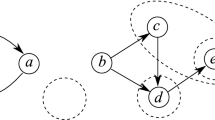Abstract
We show that the algorithm directly induced by the viability definition in Ref. [4] does not terminate in general. As a consequence, RUE-resolution in strong form is not complete. Moreover, we show that ground query processing forcovered pure logic programs can be reduced to computing viability. Since the problem of ground query processing is strictly recursively enumerable even under the above restrictions, it follows that the notion of viability is undecidable. Finally, we present a modified viability check that solves the non-termination problem for ground terms.
Similar content being viewed by others
References
Blair, H. A., ‘Canonical conservative extensions of logic program completions’,Proc. 4th IEEE Symp. on Logic Programming, IEEE Computer Society Press, pp. 154–161 (1987).
Blair, H. A. and Subrahmanian, V.S., ‘Paraconsistent logic programming’,Theoretical Computer Science 68, 135–154 (1989).
Chang, C. L. and Lee, R. C. T.,Symbolic Logic and Mechanical Theorem Proving, Academic Press (1973).
Digricoli, V. J. and Harrison, M. C., ‘Equality based binary resolution’,JACM 33(2), 253–289 (1986).
Digricoli, V. J., Lu, J. J. and Subrahmanian, V. S., ‘And-Or graphs applied to RUE-resolution,Proc. IJCAI-89, 354–358 (1989).
Lloyd, J. W.,Foundations of Logic Programming, Springer-Verlag (1987).
Lu, J. J. and Subrahmanian, V. S., ‘Completeness issues in RUE-NRF deduction’, LPRG-TR-88-24, Syracuse University (1988).
Lim, Y. and Henschen, L. J., ‘A new hyperparamodulation strategy for the equality relation’,Proc. IJCAI, 1138–1145 (1985).
Mancarella, P. and Pedreschi, D., ‘An algebra of logic programs’,Proc. 5th Intl. Conf. and Symp. on Logic Programming (eds. K. Bowen and R. Kowalski), MIT Press, pp. 1006–1023 (1988).
Mancarella, P., Pedreschi, D., Rondinelli, M. and Tagliatti, M., ‘Algebraic properties of a class of logic programs’,Proc. of the 1990 North American Conference on Logic Programming (eds. S. Debray and M. Hermenegildo), MIT Press, pp. 23–39 (1990).
McCune, W. W., ‘Negative paramodulation’,Proc. 8th Conf. on Automated Deduction, Lecture Notes in Computer Science Vol. 230, Springer-Verlag, pp. 229–239 (1986).
McCune, W.W. and Henschen, L.J., ‘Experiments with semantic paramodulation’,J. Automated Reasoning 1, 231–261 (1985).
Morris, J. B., ‘E-resolution: an extension of resolution to include the equality relation’,Proc. 1st IJCAI, Washington DC, pp. 287–294 (1989).
Sebelik, J. and Stepanek, P., ‘Horn clause programs for recursive functions’, in:Logic Programming (eds. K. Clark and S. A. Tarnlund), Academic Press, pp. 324–340 (1982).
Wos, L. and Robinson, G. A., ‘Paramodulation and theorem proving in first order theories with equality, in:Machine Intelligence 4 (eds. B. Meltzer and D. Michie), pp. 135–150 (1969).
Wos, L., Overbeek, R. and Henschen, L., ‘Hyperparamodulation: A refinement of paramodulation, inProc. 5th Conference on Automated Deduction, Lecture Notes in Computer Science, Vol. 87, Springer-Verlag, pp. 208–219 (1980).
Author information
Authors and Affiliations
Additional information
Work supported in part by NSF grants IRI-9015251 and IRI-9109755 and by Army Research office grant DAAL-03-92-G-0225.
Rights and permissions
About this article
Cite this article
Lu, J.J., Subrahmanian, V.S. Completeness issues in RUE-NRF deduction: The undecidability of viability. J Autom Reasoning 10, 371–388 (1993). https://doi.org/10.1007/BF00881797
Received:
Issue Date:
DOI: https://doi.org/10.1007/BF00881797




